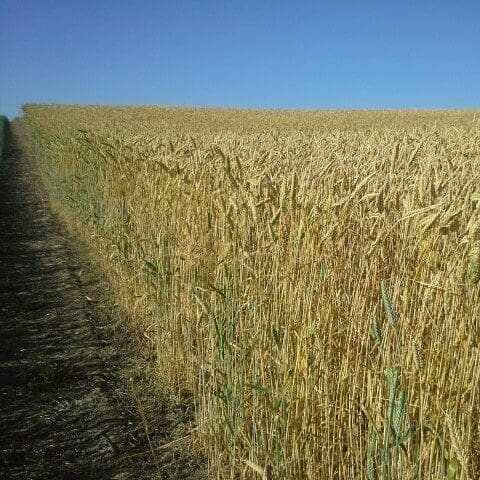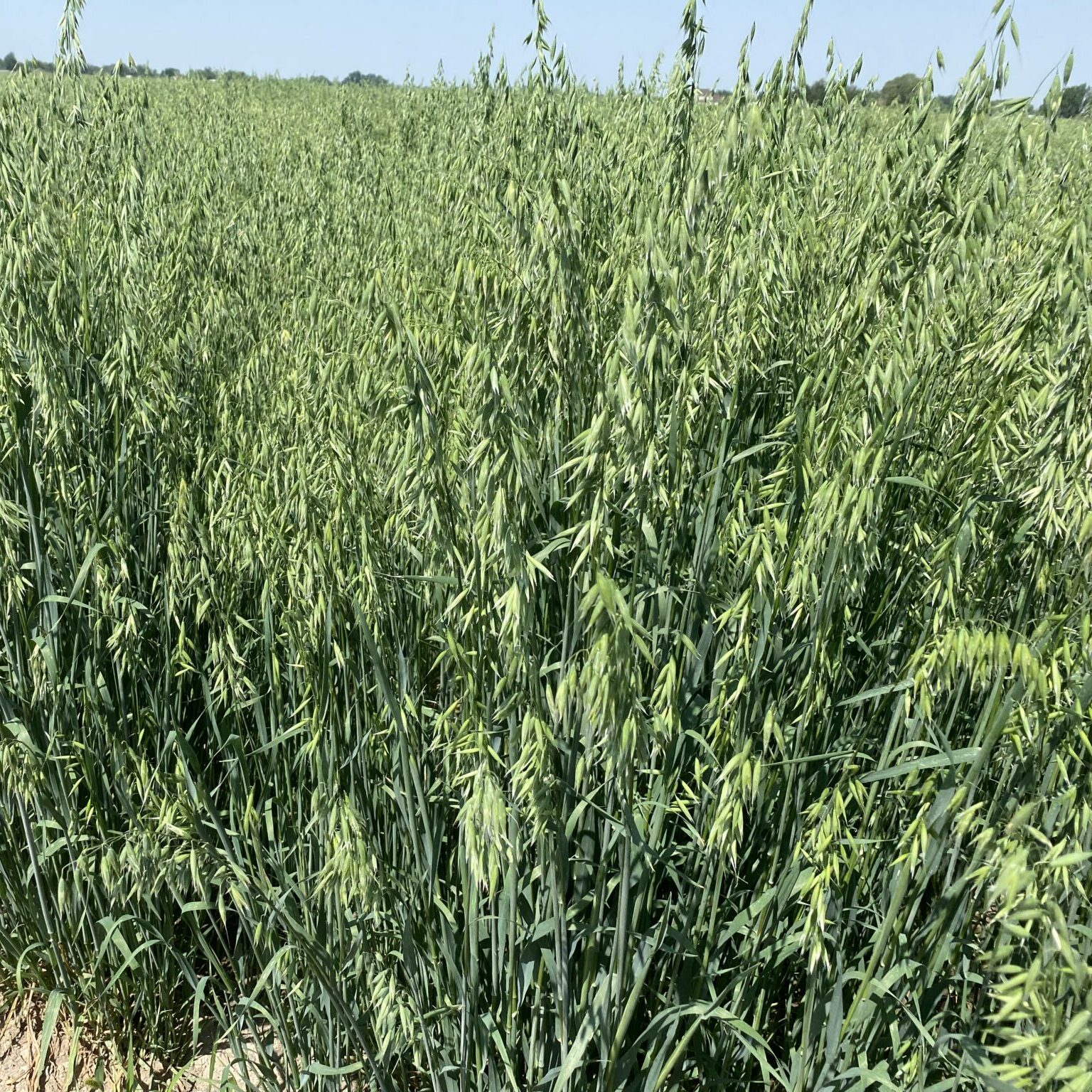









FX 1001 Triticale
- Scientific name: X tritosecale
- Beardless (Awnletted)
- High yielding winter triticale
- Very desirable for the feeding industry
- Excellent forage yield potential
- Late Maturing
- Improved yield in dryland acres
- No beads = no respiratory or sinus issues
FX 1001 is not available for purchase through our website. Please call 435-283-1411 to order.
FX 1001 Triticale “Nearly Beardless” Winter Forage Variety
FX Fall Triticale 1001 (X tritosecale) is a “nearly beardless” or “nearly awnletted” high yielding fall triticale. In development and test plots, 9,700 plants (97%) out of 10,000 were completely beardless. The remaining heads (3%) expressed a short spikelets of dwarf beard. The dramatically reduced awn expression makes this variety very desirable for forage. It has excellent forage yield potential, and winter triticale produces very high tonnage on dryland acres. This variety is a game changer for forage production across the US.
Description:
FX 1001 (X tritosecale), a nearly awnless (9,700 plants out of 10,000 are completely awnless) winter triticale bred for forage production. This variety is taller and matures earlier than other winter cereal forage standards. In addition, FX 1001 is typically three centimeters taller and three days earlier to head than other triticale, and twenty centimeters taller and heads an average of ten days earlier than Willow Creek winter wheat. Moreover, the variety was screened for winter hardiness and consistently produces forage and seed yields comparable to or exceeding Trical® 102 in dryland and irrigated trials in Montana, North Dakota, and Wyoming.
Benefits of fall FX 1001 triticale:
- Nearly Awnless: 97% of plants are completely awnless
- Reduce incidences of lump-jaw, sore eyes, and other similar concerns in livestock feeding situations
- High Yielding: Consistently high forage yields in a variety of irrigated and dryland trials
- Cold Hardy: Bred to perform in the harsh northern climates of Montana, North Dakota, Wyoming and the intermountain west.
Establishment
- Plant 1/2″ -1 1/2″ depth.
- Plant into well prepared seed bed for best germination success.
FX 1001 Brand Triticale Tech Sheet
FX 1001 Brand Triticale Tech Sheet
FX 1001 PDF Plant Brochure
Prepared By: TriCal Superior Forage
Beards, Dwarf Beards and Awnlettes
Making Sense of Grain Beards
What is the difference between “bearded” and “dwarf beard” and “beardless” varieties? How do I choose the one best for me?
The table below will help you visualize the different characteristics of each variety, if they have beards (or not) and why it matters. See our BEARDED GRAINS blog post for additional information.
| Species | Variety | Planting Season | Beard Expression | Comments |
|---|---|---|---|---|
| Oat | Otana | Spring | Beardless | Oats do not have a beard |
| Oat | Monida | Spring | Beardless | Oats do not have a beard |
| Oat | Intimidator | Spring | Beardless | Oats do not have a beard |
| Oat | Monico | Spring | Beardless | Oats do not have a beard |
| Oat | Magnum | Spring | Beardless | Oats do not have a beard |
| Oat | Everleaf™ Falcon Oat | Spring | Beardless | Oats do not have a beard |
| Oat | Everleaf™ 126 Oat | Spring | Beardless | Oats do not have a beard |
| Barley | Vaquero | Spring | Beardless | May express a beard up to 4/10,000 plants (.04%) |
| Barley | Sunstar Double | Spring | Bearded | Bearded forage barley |
| Barley | Claymore | Spring | Bearded | Bearded forage barley |
| Barley | Haymaker | Spring | Beardless | Forage barley |
| Barley | Lavina | Spring | Beardless | Forage barley |
| Barley | Goldeneye | Spring | Bearded | Grain barley |
| Barley | Sunstar Pride | Fall | Bearded | Fall forage barley |
| Barley | Valor | Fall | Beardless | Fall forage barley |
| Barley | Baldwin | Fall | Awnletted | Beard expression if planted after October 15 |
| Triticale | Merlin Max™ | Facultative | Beardless | Forage triticale |
| Triticale | Gunner™ | Facultative | Beardless | Forage triticale |
| Triticale | 131 | Fall | Beardless | Forage triticale |
| Triticale | 141 | Spring | Awnletted | 141 was used facultatively at high elevations |
| Triticale | Luoma | Fall | Awnletted | Forage triticale |
| Triticale | Flex 719™ | Facultative | Awnletted | Forage triticale |
| Triticale | FX 1001 | Fall | Nearly Beardless | FX 1001 may have up to 3% beard expression |
| Triticale | Motley™ | Facultative | Nearly Beardless | Forage triticale |
| Wheat | Jefferson | Spring | Bearded | Hard red grain wheat for milling |
| Wheat | Twin | Spring | Beardless | Soft white forage wheat |
| Wheat | Brundage | Fall | Beardless | Soft white forage wheat |
| Wheat | Ray | Fall | Beardless | Hard Red forage or milling wheat |
| Wheat | Willow Creek | Fall | Beardless | Hard Red forage or milling wheat |
| Rye | Rymin or VNS | Facultative | Bearded | Cereal forage rye |
| Peas | Austrian Winter Peas | Facultative | Beardless | Peas do not have a beard |
| Grain Mixture | Fall Forage Blend | Fall | Beardless | May contain awnletted varieties |
| Grain Mixture | Prosper 3 Grain Forage Mixture | Spring | Beardless | Forage mixture |
| Grain Mixture | Prosper Plus with Peas | Spring | Beardless | Prosper with forage peas added |
Helpful Links
Additional information about this product can be found on the academic websites linked below.
Synonyms
Many plants have more than one common and scientific name. We've listed a few of them below.
- FX 1001 Triticale
- X tritosecale var. fx 1001
Who is Great Basin Seed?
Great Basin Seed is a seed company that specializes in seed sales and consultation for home, ranch, farm, range and reclamation. We have been a leader in the seed industry since 1974.
Our History
We've been in the seed business since 1974.
What We Offer
We offer seed for home, farm, ranch, range and reclamation projects.
Meet the Gang
We have the best employees in the world! We are proud of the work they do, and trust them to serve you!
Right: Company founder Lloyd and his wife Paula Stevens in a wildflower seed production field circa 1977
Quick Plant Facts
| Scientific Name: | |
|---|---|
| Elevation of Occurance: | |
| Lifespan: | |
| Origin: | |
| Plant Height: | |
| Plant Type: | |
| Min. Precipitation: | |
| Root Form: | |
| Growth Season: | |
| Seeds per Pound: | |
| Max Sowing Depth: | |
| Planting Rate: | |
| Best Time to Sow: | |
| Sun & Shade Tolerance: | Full Sun |













